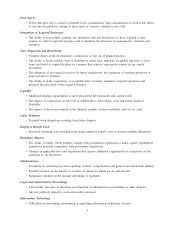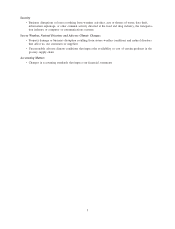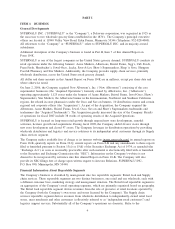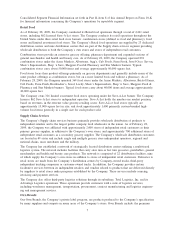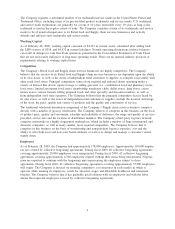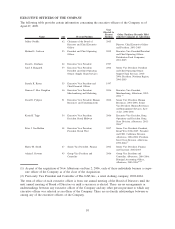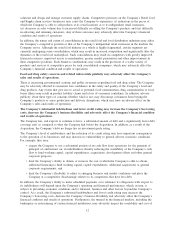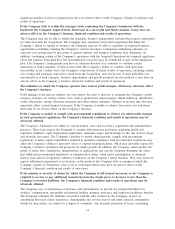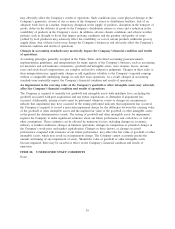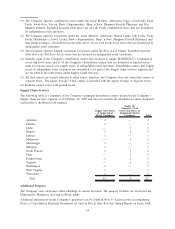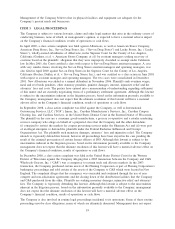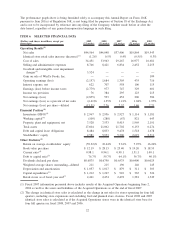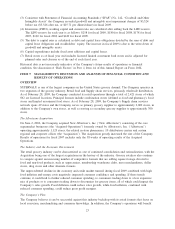Albertsons 2009 Annual Report Download - page 18
Download and view the complete annual report
Please find page 18 of the 2009 Albertsons annual report below. You can navigate through the pages in the report by either clicking on the pages listed below, or by using the keyword search tool below to find specific information within the annual report.significant number of stores as planned may have an adverse effect on the Company’s financial condition and
results of operations.
If the Company fails to realize the synergies from combining the Company’s businesses with the
businesses the Company acquired from Albertsons in a successful and timely manner, it may have an
adverse effect on the Company’s business, financial condition and results of operations.
The Company may not be able to realize the synergies, business opportunities and growth prospects anticipated
in connection with the Acquisition. The Company may experience increased competition that limits the
Company’s ability to expand its business, the Company may not be able to capitalize on expected business
opportunities, including retaining the Company’s current customers, assumptions underlying estimates of
expected cost savings may be inaccurate or general industry and business conditions may deteriorate. In
addition, combining certain of the Company’s operations with the Acquired Operations has required significant
effort and expense. Personnel have left and additional associates may be terminated as part of the integration
plan. The Company’s management may have its attention diverted as it continues to combine certain
operations of both companies. If these factors limit the Company’s ability to combine such operations
successfully or on a timely basis, the Company’s expectations of future results of operations, including certain
cost savings and synergies expected to result from the Acquisition, may not be met. If such difficulties are
encountered or if such synergies, business opportunities and growth prospects are not realized, it may have an
adverse effect on the Company’s business, financial condition and results of operations.
The industries in which the Company operates have narrow profit margins, which may adversely affect
the Company’s business.
Profit margins in the grocery industry are very narrow. In order to increase or maintain the Company’s profit
margins, strategies are used to reduce costs, such as productivity improvements, shrink reduction, distribution
center efficiencies, energy efficiency programs and other similar strategies. Changes in product mix also may
negatively affect certain financial measures. If the Company is unable to achieve forecasted cost reductions
there may be an adverse effect on the Company’s business.
If the Company is unable to comply with governmental regulations or if there are unfavorable changes
in such government regulations, the Company’s financial condition and results of operations may be
adversely affected.
The Company’s businesses are subject to various federal, state and local laws, regulations and administrative
practices. These laws require the Company to comply with numerous provisions regulating health and
sanitation standards, equal employment opportunity, minimum wages and licensing for the sale of food, drugs
and alcoholic beverages. The Company’s inability to timely obtain permits, comply with government
regulations or make capital expenditures required to maintain compliance with governmental regulations may
affect the Company’s ability to open new stores or expand existing facilities, which may adversely impact the
Company’s business operations and prospects for future growth. In addition, the Company cannot predict the
nature of future laws, regulations, interpretations or applications, nor can the Company determine the effect
that additional governmental regulations or administrative orders, when and if promulgated, or disparate
federal, state and local regulatory schemes would have on the Company’s future business. They may, however,
impose additional requirements or restrictions on the products the Company sells or manner in which the
Company operates its businesses. Any or all of such requirements may have an adverse effect on the
Company’s financial condition and results of operations.
If the number or severity of claims for which the Company is self-insured increases, or the Company is
required to accrue or pay additional amounts because the claims prove to be more severe than the
Company’s recorded liabilities, the Company’s financial condition and results of operations may be
adversely affected.
The Company uses a combination of insurance and self-insurance to provide for potential liabilities for
workers’ compensation, automobile and general liability, property insurance and employee healthcare benefits.
The Company estimates the liabilities associated with the risks retained by the Company, in part, by
considering historical claims experience, demographic and severity factors and other actuarial assumptions
which, by their nature, are subject to a degree of variability. Any actuarial projection of losses concerning
14


